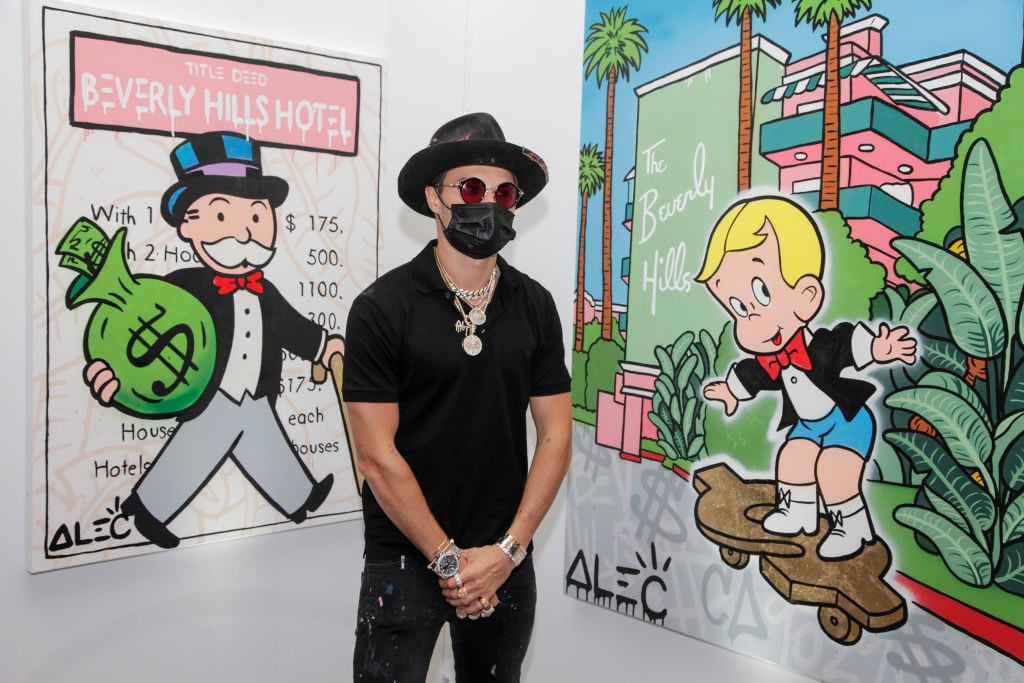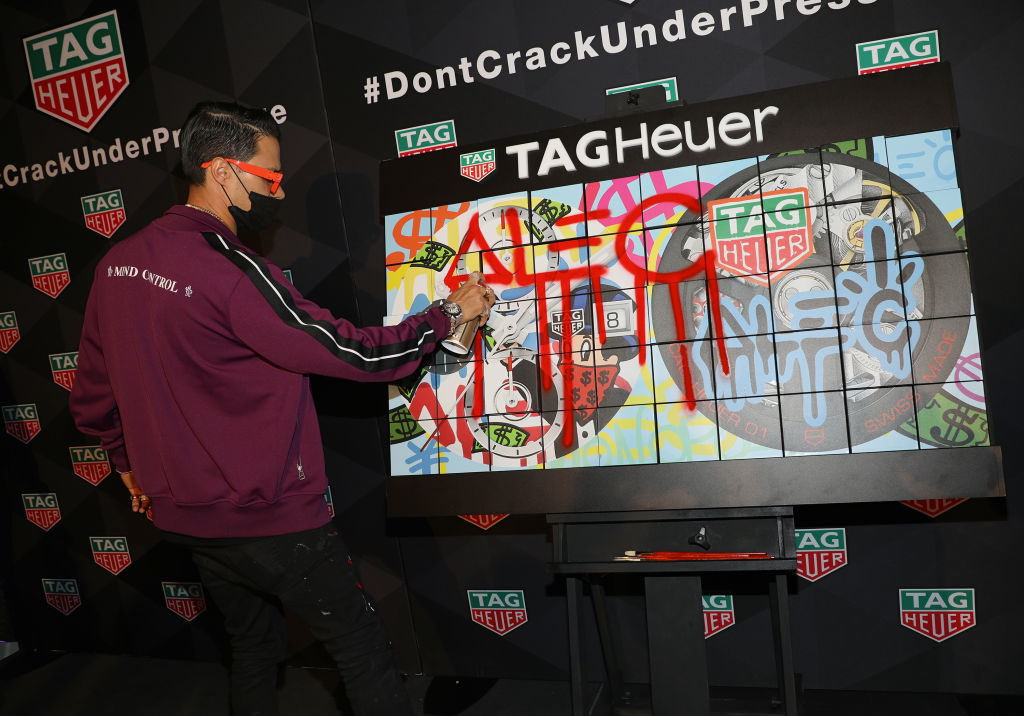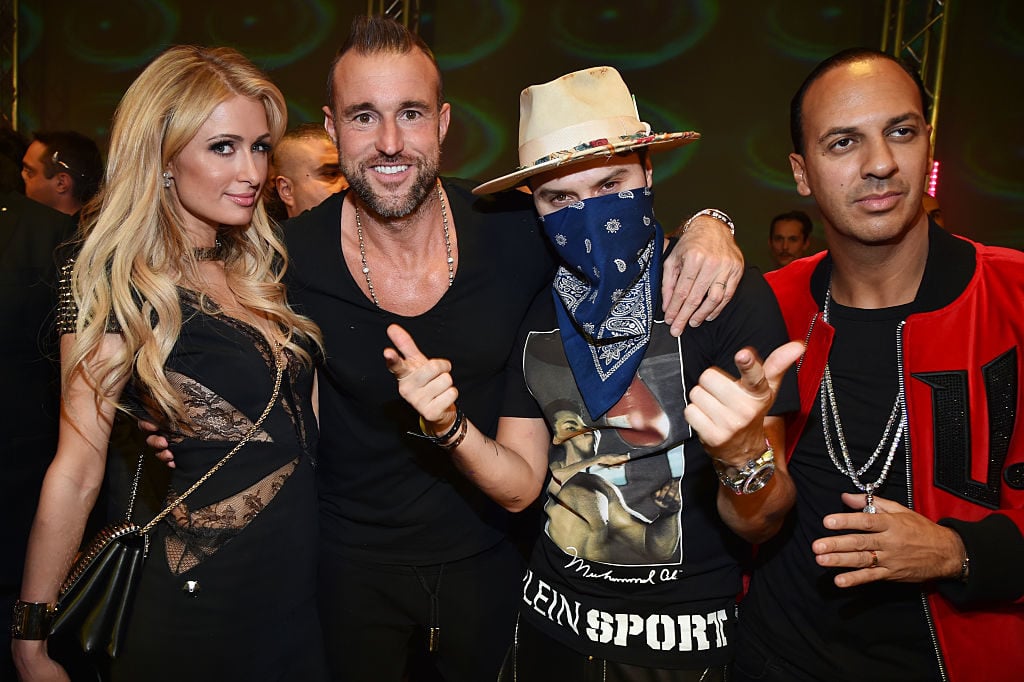People
The Art Establishment Thinks Alec Monopoly Is a Joke—But He’s Laughing All the Way to the Bank
Street artist Alec Monopoly has managed to build a successful art career without the typical art-world trajectory.

Street artist Alec Monopoly has managed to build a successful art career without the typical art-world trajectory.

Naomi Rea

Alec Monopoly is the most successful artist that art-world insiders don’t take seriously.
Mentioning street art—and Monopoly in particular—in certain circles will earn you a haughty sneer at best. As the now-defunct website Gawker once put it, Monopoly’s success is built off of selling “dumb art to foolish people for large sums.”
And yet: Monopoly was the seventh most-searched artist in artnet’s Price Database last year, has more than a million Instagram followers, and counts celebrities including Miley Cyrus and Snoop Dogg among his collectors. Online, the 33-year-old shares snaps of himself with his face covered (to protect his anonymity from law enforcement unhappy with his graffiti, he says) as he enjoys a high-end LA lifestyle ostensibly bankrolled by his art career.
He is among 100 artists who have seen the biggest gain in interested users on the artnet Price Database since 2005, coming in at number 79—ahead of Anish Kapoor (#80), Agnes Martin (#85), Ugo Rondinone (#86), and even Jeff Koons (#87). This summer, his gallery, Eden Fine Art, bankrolled a new body of work complete with an enormous inflatable Mr. Monopoly figure floating off the coast of Mykonos.
View this post on Instagram
Mr @alecmonopoly painted me a money bag!!! ??? leave it to Alec to understand my alter ego ?
A post shared by Khloé (@khloekardashian) on
But Monopoly says the public beyond the insular art world is the audience that most excites him. “People that follow me are invited to my world and become a part of my art, my statement,” he tells artnet News.
As always when it comes to making money, it helps if you’re born into the right milieu. Monopoly grew up in New York City as the child of a hard-working but comfortable family, including a mother who was a classically trained painter, so “art and painting was always in my life,” he says.
As a teenager, Monopoly dabbled in skateboarding and graffiti, and went on to double major in art and business in college before dropping out. He was making graffiti outside alongside art in the studio, but he says he didn’t really connect the two until 2008. The same year the stock market crashed, the Great Recession began, and the one percent experienced a worldwide reckoning, Monopoly found his brand—and his new name. (His real name is a badly kept secret.)

Art Provocateur Alec Monopoly celebrating the new TAG Heuer Boutique Aventura. Photo by Alexander Tamargo/Getty Images for TAG Heuer.
He began depicting the recognizable figure of Mr. Monopoly, which resonated with people as an apt metaphor for corporate greed and a stand-in for Wall Street scammers like Bernie Madoff. He presented the figure alongside other Pop characters brandishing bags of cash, including Scrooge McDuck, Richie Rich, and the Simpsons’s Mr. Burns.
Today, Monopoly mainly works on commission, which he acknowledges is unusual for a street artist. “This is one of the keys to making my work more respectable,” he says. “I don’t want to see someone the next day with a water gun removing my hard work.” He has also continued to make paintings and editions, as well as painted accessories such as handbags and sneakers.
While his particular brand of Pop-inflected familiar imagery is on its face a send-up of capitalism, it has also proven appealing to brands like Tag Heuer and Philipp Plein, with whom he has collaborated. “I use many symbols of prosperity in my works, and this plays well into many luxury brands,” he says.
Monopoly sees these collaborations as a “new means of expression” and enjoys the challenge of translating his work onto a watch face or a handbag. Asked if he ever worries the partnerships will harm his street cred, he cites others who have teamed up successfully with luxury brands, like Takashi Murakami, Jeff Koons, and Virgil Abloh.
“In 2019, there is no superficial limit between art, street art, galleries, and brands.” he explains. “The world of art has opened up. It allows artists a much more extensive range across various creative outlets.”

Paris Hilton, Philipp Plein, Alec Monopoly and guest at Milan’s Fashion Week in 2017. Photo by Jacopo Raule/Getty Images for Plein Sport.
Ostensibly a commentary on consumerism and a critique of cartoonish villains, Monopoly’s work contrasts with his online persona, which so fully embraces “flex culture” (i.e. ostentatious displays of wealth and frivolity) that one is tempted to think it is all a performance connected to his art. His habitual garb of gold chains and a jaunty top hat also leans towards the farcical.
Asked whether we should be taking him at face value or with a certain degree of irony, he says his work cannot be reduced to simple criticism of the wealthy. “I want people to see how Wall Street and the capitalistic are ingrained in the culture, and how this translates into all of our lives,” he says.
Those who like and share his images become a part of his artistic statement, which does not aim to place a value judgment on society. “Are we so evil for working hard to achieve success and live the life that we have strived for since childhood?” he asks. “Perhaps there is irony in that somewhere, or maybe I am just another artist trying to shed light on a broken system in the best way I know how.”